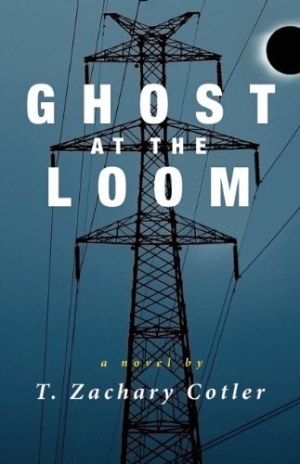Ghost at the Loom
Cotler channels classic poets to imbue his narrative with fluid sound and rhythm.
T. Zachary Cotler illuminates the beautiful, disturbed mind of a fictional poet in his transcendent novel, Ghost at the Loom. Cotler, known and recognized with awards as a poet, turns to the novel form but makes it his own by infusing more than a little poetic sensibility.
Cotler’s main character, poet Rider Sonnenreich, drifts through the book in a half-recalled, half-real odyssey, searching for his sister Leya. Sometimes it’s a physical search, other times it’s a sense of longing for a connection once held. But though this search is the major driver of the plot, what makes Ghost at the Loom a unique and beautiful book is the way Cotler brings the close attention of poetry to his writing—it’s not just the meaning of Rider’s words that is important but also their shape, sound, and rhythm.
The book demands a poetic mindset, requiring full immersion rather than a casual reading. Readers who make that commitment will be well rewarded; even simple declarative sentences absorb the nuance of poetry: “Run, Bronner says. I do, in the shallon and fescue.”
The “ghost” of the book’s title is mentioned in a letter attributed to Percy Bysshe Shelley, the most prominent of several classic poets who become part of the story, to a greater or lesser degree: “A ghost is but a stranded coil of information in an era hostile to it.” A parallel can be seen between Rider and the “ghost” in this quote; Cotler makes a statement on the chaos of 21st-century life, but it is artfully concealed, and artfully revealed.
Ghost at the Loom reads like a mellifluous fever dream, and as such, it affords readers a glimpse into a fascinating fictional mind. As Rider talks of his “glimmer,” a state of mind reached only under certain conditions, and his “image drum,” readers can get a sense of what it might be like to live with poetry visible everywhere and constantly bubbling within, ready to emerge when given the opportunity, or to force an opportunity, if not provided an outlet.
Reviewed by
Peter Dabbene
Disclosure: This article is not an endorsement, but a review. The publisher of this book provided free copies of the book to have their book reviewed by a professional reviewer. No fee was paid by the publisher for this review. Foreword Reviews only recommends books that we love. Foreword Magazine, Inc. is disclosing this in accordance with the Federal Trade Commission’s 16 CFR, Part 255.

